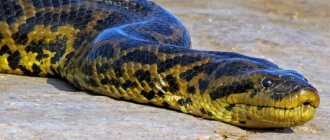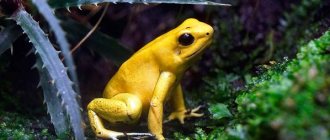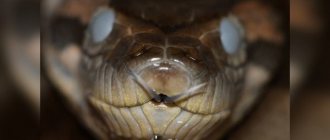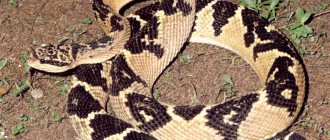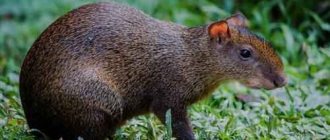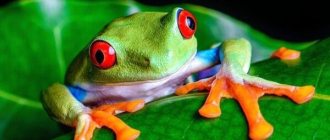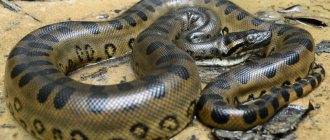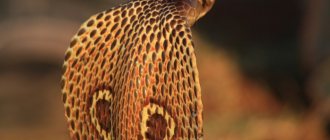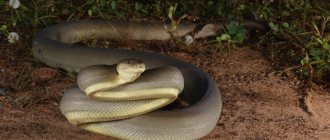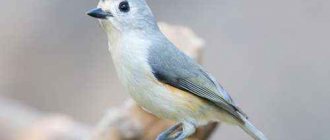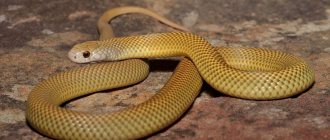How do they hunt and kill, are anacondas poisonous?
They tightly wrap themselves around their prey, that is, like all non-venomous snakes (pythons, boa constrictors and others). These representatives of reptiles kill their food by suffocating it. Anacondas, most often firmly holding the head of the victim with their jaws, braid their powerful bodies around the carcass of the caught animal and press, intensively squeezing the flesh until the victim suffocates and dies.
Other methods of murder
When the snake is still young, its hunting technique is slightly different. Indeed, given that it is less heavy, it positions itself on a tree branch and falls onto its prey as it passes under it. At an older age, a real anaconda only lifts its head out of the water and waits patiently for its prey to come up and start drinking. Possessing sharp teeth, it first sinks its fangs into its prey and then immobilizes it by wrapping its body around it. Finally, he lowers him to the bottom of the water to drown him.
It feeds mainly on rodents and birds, which it watches at night. But it can also swallow larger animals such as a dog, goat or even another snake.
Who is the giant snake afraid of?
But these apex predators are not untouchable. Besides humans, the giant anaconda has only two natural predators with which it can sometimes have fearsome fights: the black caiman and the jaguar.
Anacondas are also ophiophagous, meaning they can feed on the same species they belong to. Unlike king cobras, which are considered exclusively king cobras, anacondas not only feed on their own species, but it is not uncommon to see a female anaconda feeding on a male. If an anaconda is injured, it can also become a victim of a school of piranhas, which are especially voracious when they smell blood in the water.
Range, habitats
The yellow anaconda lives in the south of Brazil, Bolivia, Paraguay, Uruguay, and Argentina. Tropical and subtropical forests with high levels of humidity, calm rivers and other bodies of water, creeks, and swamps are the favorite habitats of this animal, whose existence is impossible without water. Sometimes flooded areas can become its habitat.
Features of representatives of the species
Anacondas are semi-aquatic snakes, meaning they live on land but are also very good swimmers and enjoy being submerged in water, where they can remain for long periods of time. Their eyes and nostrils are located closer to the top of their heads, making them ideal for moving along the surface of a river or swamp.
These species have what is called highly developed sexual dimorphism. This means that there is a big difference between males and females. In the anaconda, the difference is determined by size, the female is at least twice as large and, therefore, heavier than the male.
More on the topic: Top 10 city parks in Europe
Among the largest individuals, females were found nine meters long and weighing 250 kg. Can we say that this makes it the largest and heaviest snake in the world? The answer to this question awaits at the end of the article.
Green anaconda (Eunectes murinus)
This species of anaconda, as the name suggests, is dark green in color with black markings on its sides and throughout its body. Brands vary from person to person. It is the largest of the four species of anaconda in South America.
They are very good swimmers and feed on fish, large rodents, and sometimes jaguars, which are also their main predators.
These individuals are found in tropical rivers of South America.
Bolivian anaconda (Eunectes beniensis)
As described in its name, this species of anaconda is found in the swamps of the uninhabited plains of Bolivia. It is relatively similar to the green anaconda in size (only 1 m shorter on average), but is generally distinguished by its darker skin, which is more black than green.
Its preferred prey are large rodents, birds and some large mammals such as deer.
Yellow anaconda (Eunectes notaeus)
The yellow anaconda is one of two smaller species of anaconda along with the dark-spotted anaconda. We are talking here about females (hence larger than males) up to 4 m and weighing about 40 kg. These anacondas can be recognized by their greenish-yellowish skin mottled with black spots. Its natural habitat is near water sources and among dense vegetation throughout South America.
It feeds mainly on fish, wild pigs and large rodents.
Its beautiful scales have done a disservice, as the species has been the victim of poaching for its meat and skin: it is also an endangered species.
Deschauenseei's dark-spotted anaconda (Eunectes deschauenseei)
This species of anaconda is the same size as the yellow anaconda and is recognized by its light brown scales with black spots, similar to the color of python scales. It is found in large areas ranging from French Guiana, Suriname and northern Brazil. It lives in swamps and wetlands of these lands. The peculiarity of this species is that it climbs mountains without hesitation, to a height of up to 300 m, unlike other species.
Its diet consists of large rodents, birds, fish, and sometimes small alligators, which themselves hunt the anaconda.
The species is also endangered, the destruction of its natural habitat for human exploitation and herders who hunt it to protect their livestock have made it an endangered species.
Albino Anaconda
In the animal world, color plays a key role. Sometimes it can indicate the sex of the animal, as is the case in the avian kingdom, where male birds tend to be more colorful than females. Sometimes color can be a warning sign to stay away, such as with poison dart frogs or venomous coral snakes. And of course, many animals use their colors for protection—to camouflage themselves while hunting or to avoid being eaten.
So what happens when an animal is born an albino and lacks the ability to produce melanin, which determines the colors of the animal's skin, eyes or fur? What does it mean when an albino turtle can't blend into a layer of seaweed or an albino alligator can't hide in the dark depths of a swamp? Unfortunately, this often means that these animals do not survive long in the wild, as they are easier to see for both predators and prey. And the lack of pigment can also cause albinos to have poor vision, making it difficult to spot a hunter or their next meal.
The albino white anaconda is at a great disadvantage in that it is easy to spot for both predators and prey. This means that they are unable to survive for long in the wild. They have a white belly and yellowish scales.
At home, living in a terrarium, white snakes have no problems with survival; people help them. There is a case that one representative lived to be 28 years old, a period unknown in nature.
Lifestyle
Anaconda has a very calm character. She can remain motionless for days on end, sometimes even giving the impression of being dead. At the same time, it is well camouflaged and invisible.
Anacondas are characterized by molting. During this period, they spin and rub themselves on stones and the bottom of reservoirs, completely removing the skin. Old scales remain in the water.
The reptile is considered a nocturnal resident, since this is the time of day when it is most active. The snake hunts quite rarely, since digestion is very slow.
Important! The usual environment for existence is water. Without it they are unable to exist. When the reservoir dries up, the snake looks for another one or goes into hibernation.
It has been recorded that the lifespan of a snake in captivity is almost two times shorter. The reptile lives in terrariums for no more than 6 years.
Anaconda breeding
The anaconda, like many animals, has breeding seasons. The female sends pheromones to attract males, calling him with a peculiar smell. However, there will be no relation here to classical reproduction. Some males will be attracted to the female's pheromones, and they will all wrap around the female, forming a "breeding ball". All males then compete and this can last from two to four weeks. Once the female is fertilized, the males leave and return to normal life.
More on the topic: Nature reserves of Goa
The female, when we talk about her, has a peculiarity compared to most other snakes and even in the reptile world: she is ovoviviparous. That is, she does not immediately lay eggs, they remain and develop in her, then the moment of laying comes and the cubs appear almost immediately. The pregnancy will take six to seven months, and at term the female will have given birth to between 20 and 40 cubs, knowing that this number may vary depending on the size of the mother. Litters of 100 cubs have been recorded.
Interesting facts about anacondas
The giant anaconda snake always causes a stir, whether it's incidents involving people who regularly travel the world or the myths surrounding the impressive reptile. A brief overview of the most important facts.
Is the anaconda the largest snake in the world?
If you look only at the length, you can answer this question in the negative. In terms of both the average and maximum length of an officially verified specimen, so-called reticulated pythons are the longest snakes in the world, not anacondas.
Anacondas can reach at least over 6 meters in length, and the largest specimen ever measured was an incredible 10.6 meters long. Reports of anacondas measuring 15 meters or more in length continue to appear, but should be treated with caution.
However, no snake can dispute the size and bulk of the anaconda, it is definitely the fattest snake in the world. At its thickest, it can reach a circumference of up to 1 meter and weigh about 100 kilograms. They say that the record holder weighed an incredible 227 kilograms.
Is the anaconda dangerous for humans?
There have been repeated reports of incidents involving anacondas. The latest example is the Canadian boys who became victims of their pet snake because they were asleep and could not free themselves from its embrace.
This should not have happened if precautions had been taken. But the terrarium was not securely closed. However, the fact is that a snake only attacks people when it feels threatened.
Speaking of attacks, the anaconda is not a venomous snake, but it does have over 100 sharp teeth that it uses to bite its prey and then coil itself around it. Compressing its veins, wrapping itself around him, it loses consciousness.
Where does the word "anaconda" come from?
Even if anacondas are primarily from South America, the origin of the word in Tamil can be suspected. The translation would be “elephant killer.”
By the way, in Latin the large anaconda is called Eunectes murinus. What still applies to a snake with the word "good swimmer" is rather incorrect with the designation "gray mouse".
Where in Russia can you find an anaconda?
The anaconda, of course, is native to South America. But it can also be found in Russia - of course, only from a safe distance, in various zoos.
Where does the largest domesticated snake of this genus live?
The most attractive "domestic" example is certainly the anaconda from the Vienna Sea House, which even claims to be the largest specimen in Europe. It appeared in October 2019, had a length of 5.4 meters and a combat weight of about 100 kilograms.
Why are the snake's eyes and nose raised so high?
If you look at the snake's head longer, you will see that the eyes and nose are located relatively close to each other and are at the highest point. The reason for this is very simple: as a hunter who strikes often and happily in bodies of water, this allows the snake to submerge its body almost completely in the water to be able to stalk its prey as best as possible.
More on the topic: The highest peaks of the Alps
Why does a snake not suffocate due to swallowing the carcass whole?
The anaconda is known for not chewing or chewing its prey, but rather swallowing it whole and digesting it. But how can you possibly choke for hours without suffocating? Here evolution has created an expandable larynx at the back of the mouth.
When the snake draws in its prey, it pushes the larynx forward towards the mouth opening and, comparable to a snorkel, receives air.
She can fast for two years
It's quite surprising, but the giant anaconda has the ability to go without eating for two long years.
Notes
- Ananyeva N. B., Borkin L. Ya., Darevsky I. S., Orlov N. L.
Five-language dictionary of animal names. Amphibians and reptiles. Latin, Russian, English, German, French. / under the general editorship of academician. V. E. Sokolova. - M.: Rus. lang., 1988. - P. 275. - 10,500 copies. — ISBN 5-200-00232-X. - [snakess.ucoz.ru/publ/udavoobraznye_ili_lozhnonogie_zmei/1-1-0-18 Boa constrictors, or pseudopods, snakes. SNAKES. SITE-ENCYCLOPEDIA.] (Russian). snakess.ucoz.ru (December 10, 2012). [www.webcitation.org/6CxceLvxI Archived from the original on December 16, 2012].
- ↑ 12
[terraria.ru/eunectes1 Eunectes notaeus Paraguayan Anaconda] (Russian). terraria.ru (December 10, 2012). [www.webcitation.org/6CxcgyJUO Archived from the original on December 16, 2012].
| This is a draft article on herpetology. You can help the project by adding to it. |
Danger to humans. Truth and myths
There are legends in the Amazon about the anaconda Eunectes murinus. The current record is 9 meters in length. However, the craziest rumors are circulating. Someone would see an anaconda 15 m, even 20 m.
Anaconda very rarely attacks humans. However, the myth of the man-eating anaconda has taken root in the collective unconscious of the Amazon population.
What is it really?
Despite numerous reports of a giant anaconda swallowing a man, none of them seem plausible. Indeed, the anaconda is much less aggressive than the reticulated python, and its attacks on humans are rare. And although she is physically capable of strangling and eating a child or teenager. There was a case in India when a predator ate a 13-year-old boy.
However, the giant anaconda is not the terrifying man-eater that people think it is. She will not be able to defeat an adult. There are many cases of non-fatal attacks, especially bites. But people are capable of killing a snake 8 or more meters long. They are already listed as a protected animal in South America due to regular poaching. The reason is the beautiful color of the leather, which is valued in luxury products: shoes, bags. Snake meat is considered a delicacy by many peoples.
Grow all your life
These already rather large creatures grow throughout their lives. This also applies to pythons and boa constrictors. The first years of life the snake grows very quickly , then the growth rate of their body slows down significantly. Despite its large size, this snake often becomes a victim of predators, such as a jaguar or a caiman. A wounded reptile can even attract a flock of piranhas.
Anaconda in a home terrarium
While snakes fascinate, surprise and frighten some, they are mostly unknown to the general public. For many, the snake is vicious, aggressive and slithery; films or cartoons that do not help improve their image. However, die-hard enthusiasts are practicing something that might make some people break a sweat: terrariums.
It's about a passion for reptiles that goes so far as to keep them at home. These could be lizards, turtles and, of course, snakes. There are so many types of snakes that you can keep in your home. Anaconda is one of them. It is not included in the list of prohibited representatives, and is also not poisonous. Given its size, it will not be easy to maintain.
The container is selected according to size. The main rule is comfort and not being able to get out. This species is a lover of fresh water, so you need to put a bathing suit or bath. Considering the length, it should be a container of at least 1 meter. She needs to swim.
The snake does not require special care. Now you don't need to feed her every day. First of all, the snake needs attention and observation. Any skin problems should be closely monitored. The snake needs, first of all, precise conditions in captivity. The humidity level should be ideal - 90 percent, and the temperature too - from 25 to 32 degrees. The water needs to be changed weekly to prevent the appearance of mites and parasites. The terrarium needs to be washed relatively often.
Diet
The snake's diet is quite simple. Whether it's a boa constrictor, a royal python or an anaconda, they all feed on the same thing, namely rodents (rats, mice, hamsters). The only difference will be in the size of the prey for these snakes, as they do not all have the same body type or the same cleanliness requirements.
Answers to pressing questions
Question No. 1. Is it possible to have an anaconda at home?
Anacondas live in zoos around the world. In addition, sometimes reptiles live in home terrariums. These are usually green or Paraguayan anacondas.
When choosing a pet in this way, herpetologists recommend purchasing a young individual. It is easier to accustom a cub to people, besides, such an animal has small teeth and if bitten it will not cause significant injury.
It is better to have a baby anaconda at home
Question No. 2. In what conditions should an anaconda be kept?
Anaconda is kept in a terrarium. Since the snake loves water, it needs a tray with liquid or a special pool. However, you should carefully monitor the cleanliness of the reservoir.
It is important to observe the temperature regime: the recommended water temperature is 23-24 degrees, and the air is 27-30°C.
It is also worth considering that the anaconda does not like being close to its relatives. Therefore, each reptile needs a personal terrarium.
